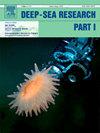沿Cocos岭的生物硅循环:原位和非原位提取孔隙水之间的差异意味着在岩心恢复时溶解硅的吸收速度很快
IF 2.1
3区 地球科学
Q2 OCEANOGRAPHY
Deep-Sea Research Part I-Oceanographic Research Papers
Pub Date : 2025-07-04
DOI:10.1016/j.dsr.2025.104554
引用次数: 0
摘要
海洋沉积物中硅(Si)的循环对全球海洋营养动态和生产力具有重要影响。利用独特的原位和传统的非原位孔隙水收集技术,以及固相分析、岩心培养和沉积物捕集器收集技术,研究了科科斯岭和赤道东太平洋上覆水域沉积物中的硅循环。Si再矿化和埋藏通量在4个调查地点之间几乎没有变化,而不管站点之间的水深相差约1600 m。原位采集的沉积物深度为10cm的孔隙水中溶解硅浓度显著且持续高于非原位采集的孔隙水中溶解硅浓度,这意味着与沉积物岩心恢复和处理相关的先前未被识别的采样人为影响。非原位孔隙水中溶解硅的损失也与硅同位素的分馏有关。4个测点中有3个测点的原位孔隙水δ30Si比非原位孔隙水δ30Si轻,只有1个测点的孔隙水δ30Si明显轻。非原位孔隙水中轻硅的优先损失归因于岩心收集和从寒冷高压底栖生物到海洋表面的运输过程中自生粘土的形成。然而,在沉积物水界面10厘米范围内,原位和非原位孔隙水Si梯度的一致性表明,先前使用沉积物岩心衍生孔隙水确定的再矿化通量仍然准确。本文章由计算机程序翻译,如有差异,请以英文原文为准。
Biogenic Si cycling along the Cocos Ridge: differences between in situ and ex situ extracted pore waters imply rapid rates of dissolved Si uptake upon core recovery
The cycling of silicon (Si) in marine sediments can have major impacts on global ocean nutrient dynamics and productivity. Si cycling in the sediment of the Cocos Ridge and overlying waters of the eastern equatorial Pacific was investigated using unique in situ and traditional ex situ pore water collection techniques as well as solid phase analysis, core incubation, and sediment trap collection. Si remineralization and burial fluxes show little variation between the four sites investigated, regardless of a ∼1600 m difference in water depth among stations. Dissolved Si concentrations in pore water from sediment depths >10 cm collected in situ were significantly and consistently higher than those collected ex situ implying a previously unrecognized sampling artifact associated with sediment core recovery and processing. The loss of dissolved Si in the ex situ pore waters is also associated with the fractionation of Si isotopes. In situ pore water δ30Si is lighter than ex situ pore water δ30Si at three of the four stations, though only significantly lighter at one. The preferential loss of light Si in ex situ pore waters is attributed to authigenic clay formation during core collection and transport from the cold, high pressure benthos to the ocean's surface. However, consistency between in situ and ex situ pore water Si gradients within 10 cm of the sediment water interface indicates remineralization fluxes previously determined using sediment core-derived pore waters remain accurate.
求助全文
通过发布文献求助,成功后即可免费获取论文全文。
去求助
来源期刊
CiteScore
4.60
自引率
4.20%
发文量
144
审稿时长
18.3 weeks
期刊介绍:
Deep-Sea Research Part I: Oceanographic Research Papers is devoted to the publication of the results of original scientific research, including theoretical work of evident oceanographic applicability; and the solution of instrumental or methodological problems with evidence of successful use. The journal is distinguished by its interdisciplinary nature and its breadth, covering the geological, physical, chemical and biological aspects of the ocean and its boundaries with the sea floor and the atmosphere. In addition to regular "Research Papers" and "Instruments and Methods" papers, briefer communications may be published as "Notes". Supplemental matter, such as extensive data tables or graphs and multimedia content, may be published as electronic appendices.

 求助内容:
求助内容: 应助结果提醒方式:
应助结果提醒方式:


